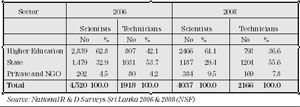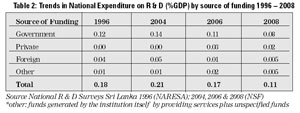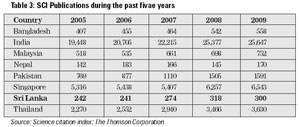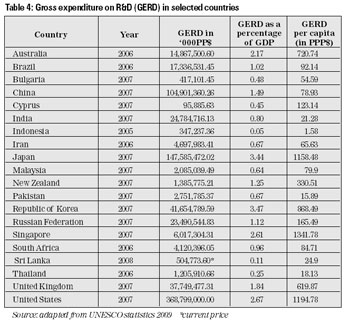Scientific research, innovation and creativity leading to technological advancements are hallmarks of economic development. This is historically evident from the rapid development of Europe, North America and Canada after the industrial revolution, the economic boost of Japan after the 2nd World War and more recently the newly emerging economies of China, India, Korea and Brazil which are predicted to be future economic giants.
Sixty three years since gaining independence it is time to look where Sri Lanka is, in comparison to other neighboring countries which were also colonies of the British Empiqe. Unfortunately, it has to be admitted that we are far behind most of them so much so that we are sending Sri Lankans to work as unskilled labourers and house maids in some of these countries. It is therefore necessary to take stock of what happened, to find out where we went wrong and explore remedial measures that can be taken to reverse this situation.
Although significant socio-political changes took place in Sri Lanka during this period to move away from the post-colonial mentality, our scientific research and industries perhaps did not keep pace with such changes to strengthen local capacity and concentrate on the utilization of indigenous resources. Even today most of our industrialists prefer to depend upon either imported technology and/or export raw material rather than add value to local resources. There is a misconception that a small developing country like Sri Lanka which has numerous socio-political responsibilities should give less priority to scientific research. It is high time that we change these attitudes and develop a positive mentality; “Yes we can, Sri Lankans can be innovative and productive”.
This country has so many endemic plants and animals and traditional knowledge going back several centuries that would have used some of these indigenous resources. Why don’t we embark upon research projects to investigate the active ingredients in such biological resources?
Similar studies should be extended to marine ecosystems and the ocean beds around this island. With the ownership of the extended economic zone we have inherited an ocean area that is 27 times that of our total land area but we have very little knowledge of the wealth of resources found there. It is time that the state and the corporate sector recognize the enormous economic potential of such studies and provide financial support for research on Natural Product Chemistry of indigenous and endemic resources of Sri Lanka. The same argument can be extended to non-biological resources in the island that had been largely underutilized. Recent advances in material science and nanotechnology open up entirely new areas of novel research for sustainable utilization of such resources that could yield products of enormous commercial value.
Today there is a trend to boost our economy through industrial and developmental projects on housing and tourism with large scale foreign investments. While such steps are necessary for rapid development, we should not lose sight of the possible environmental impacts of such massive developmental projects. The immediate impact of environmental pollution is the destruction of ecosystem diversity which is the key to conservation of biodiversity. Scientific research as well as training of scientists competent to monitor environmental impacts of industrialization is another important aspect to be considered.
Already it has become evident that industrialization and the continuous use of chemical fertilizer and other agro-chemicals have resulted in the eutrophication of most of our inland water reservoirs. Research studies conducted by the author in collaboration with the National Water Supply and Drainage Board (NWSDB) and by scientists from the IFS and Universities of Peradeniya, Sri Jayewardenepura and Ruhuna have reported on the increase and changes in the algal flora of such water bodies as indicators of pollution. These studies have shown that over the years during the last century the algal flora has changed from non-toxin producing species to toxin producing blue-green algae (cyanobacteria) notably species of Cylindrospermum, Microcystis and Anabaena.
These results reported during the last couple of decades have been confirmed by studies conducted recently at the Faculty of Medicine, University of Peradeniya. It has been concluded that such toxins in water are responsible for the prevalence of kidney ailments among the people of the North Central Province of Sri Lanka. While such news is sensational it is necessary to have irrefutable scientific data as there are other factors besides algal toxins that could contribute to the occurrence of chronic kidney diseases in Sri Lanka. The IFS has the scientific capacity, techniques and equipment to detect and quantify algal toxins in water and we are hopeful of securing funds for such research.
It is necessary for the State to recognize the importance of research on water borne, vector borne and other infectious diseases which affect the health of a large proportion of the national population. Funds spent on such research would be a saving to the government in the long term. Not only do these illnesses account for a significant loss of the working manpower of the country, the government has also to provide preventive as well as curative health care to its population at enormous cost.
So far I have dealt with perhaps the more conventional areas of scientific research. The rapid developments in more modern fields of research such as Molecular Biology and Biotechnology, Computer Science, Artificial Intelligence, Communication Information Technology, Material Science and Nanotechnology are mind boggling. It is necessary to point out the enormous potential of these areas of research for national development.
Next I would like to dwell upon the local manpower capacity for scientific research. It is reported(Sri Lanka Science, Technology & Innovation Statistical Handbook, NSF 2008) that the total number of scientists recorded under Human Resources for Science & Technology was 4,037 in 2008 and this is a decline from the 4,520 the country had in 2006 (Table 1).
 |
In terms of their qualifications this includes approximately 23% PhDs, 28% M.Phil/M.Scs, 9% MD/MSs, 5% B.Sc + PG Diplomas, 16% B.Sc. Special, 15% B.Sc. General and 4% others. It should be noted that only about 60% with PhDs, MPhil/MSc and MD/MS are really competent to conduct independent research since those with bachelor’s degrees need guidance and supervision. Even most of the M.Sc. graduates are limited in their research capabilities. This means that strengthening the scientific manpower capacity is also necessary to establish a research oriented knowledge based society that that will bring about rapid economic development. Therefore institutes devoted for research such as the IFS, ITI, NERD, Universities and Postgraduate Institutes have an additional responsibility of training graduate students and orient them for research work.
All these activities need money and let us see how research and development is funded in Sri Lanka. From the data presented by the NSF Handbook, it can be seen that the Gross Expenditure on Research and Development (GERD) as a percentage of the Gross Domestic Product (GDP) has declined from 0.21 in 2004 through 0.17 in 2006 to 0.11 in 2008 (Table 2).
Contributions by the private sector have been dismal with 0% in 2004, through 0.03% in 2006 to 0.02% in 2008. Even foreign funding has declined from 0.05% to 0.01% to 0.005% during these three years. Research output of Sri Lanka in terms of publications included in the Scientific Citation Index (SCI) is nothing to be proud of (Table 3).
In comparison to other countries in our region we occupy the last but one position, just ahead of Nepal. Interestingly enough this position coincides with our funding status among many other countries, occupying the last but one position as shown below.
In comparison to the 20 countries listed in Table 4 Sri Lanka occupies the last but one position with its contribution at 0.11% of the GDP in 2008 just ahead of Indonesia with 0.05% in 2005. This is a reflection of the status and recognition given by the government of Sri Lanka for research and development. It is therefore quite evident that there should a radical change in the attitude of our policy makers towards scientific research.
The scientific community has a critical role to play to bring about such attitudinal changes. In this respect professional associations such as the National Academy of Sciences, the Sri Lanka Association for the Advancement of Science, Institute of Engineers Sri Lanka, Institute of Chemistry, Institute of Physics, Institute of Biology etc have a responsibility to interact closely with policy makers and administrators and convince them of the importance of Research, Innovation and Technology for National Development. Sri Lanka possesses resources that can be better utilized for its economic development. We also have well qualified, capable and competent scientists and technologists who can provide leadership and training to strengthen the scientific manpower requirements of this country. All that is necessary is a National Policy on Science and Research which is directed towards strengthening local industries and other economic sectors while minimizing the negative impacts on our environment.
Such a policy should be supported with adequate funding and incentives to scientists who contribute to economic development and improvement of the quality of life of this nation.
|





